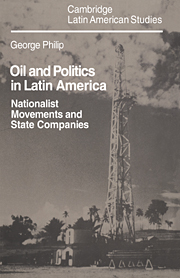Book contents
- Frontmatter
- Contents
- List of tables
- Preface
- Glossary
- Abbreviations
- Note on currencies and other units of measurement
- Maps: Latin America in 1920, 1940, 1960 and 1981; showing importing countries, exporting countries and countries self-sufficient in oil
- Introduction: The politics of oil in twentieth-century Latin America
- Part I The world oil environment
- Part II The major expropriations
- 7 Politics and the concession contract
- 8 Argentina: YPF, Yrigoyen and the 1935 oil law
- 9 Some nationalisations of the 1930s: Chile, Uruguay, Bolivia
- 10 Cárdenas and the Mexican oil nationalisation
- 11 The formation of Petrobrás
- 12 The nationalisation of the ipc in Peru
- 13 The nationalisation of Gulf Oil in Bolivia 1969
- 14 Oil politics in Ecuador 1972–6
- 15 The nationalisation of oil in Venezuela
- 16 Oil companies and governments in twentieth-century Latin America
- Part III The state oil companies
- Notes and bibliography
- Index
- CAMBRIDGE LATIN AMERICAN STUDIES
9 - Some nationalisations of the 1930s: Chile, Uruguay, Bolivia
Published online by Cambridge University Press: 23 December 2009
- Frontmatter
- Contents
- List of tables
- Preface
- Glossary
- Abbreviations
- Note on currencies and other units of measurement
- Maps: Latin America in 1920, 1940, 1960 and 1981; showing importing countries, exporting countries and countries self-sufficient in oil
- Introduction: The politics of oil in twentieth-century Latin America
- Part I The world oil environment
- Part II The major expropriations
- 7 Politics and the concession contract
- 8 Argentina: YPF, Yrigoyen and the 1935 oil law
- 9 Some nationalisations of the 1930s: Chile, Uruguay, Bolivia
- 10 Cárdenas and the Mexican oil nationalisation
- 11 The formation of Petrobrás
- 12 The nationalisation of the ipc in Peru
- 13 The nationalisation of Gulf Oil in Bolivia 1969
- 14 Oil politics in Ecuador 1972–6
- 15 The nationalisation of oil in Venezuela
- 16 Oil companies and governments in twentieth-century Latin America
- Part III The state oil companies
- Notes and bibliography
- Index
- CAMBRIDGE LATIN AMERICAN STUDIES
Summary
Following the example of Argentina and facing the general withdrawal of American capitalism during the 1930s, many Latin American countries took steps to increase state control of their oil industries. Generally speaking these steps were not as dramatic as the Mexican nationalisation and not as fully and popularly debated as the Argentine oil campaign had been (or as the Brazilian campaign was later to be), but they nevertheless played their part in the politics of oil in Latin America. Three less well-known cases will be discussed in this chapter.
Chile
Until the mid-1920s Chile had not found it necessary to define its oil policy. Chilean territory had, immediately after the First World War, attracted a certain amount of company interest. However, survey results were not promising and as a further disadvantage there was no specific oil legislation in operation at the time, with the consequence that the oil companies would have found it necessary to buy up small land titles piecemeal from local landowners. Company interest therefore subsided.
The first company to take a major initiative in Chile was Pan American which, at the end of 1926, persuaded the Chilean Congress to pass a draft law permitting oil companies to take concessions up to a maximum of half a million hectares. This also made it clear that an area of this size would shortly be offered to Pan American (a subsidiary of Standard Oil of Indiana).
- Type
- Chapter
- Information
- Oil and Politics in Latin AmericaNationalist Movements and State Companies, pp. 182 - 200Publisher: Cambridge University PressPrint publication year: 1982



